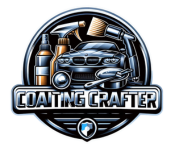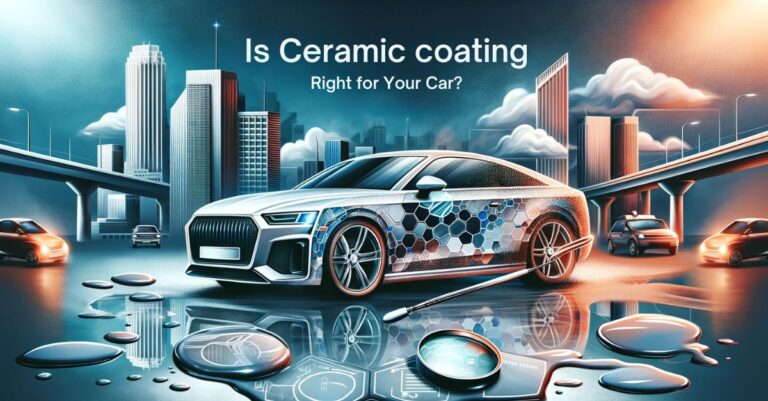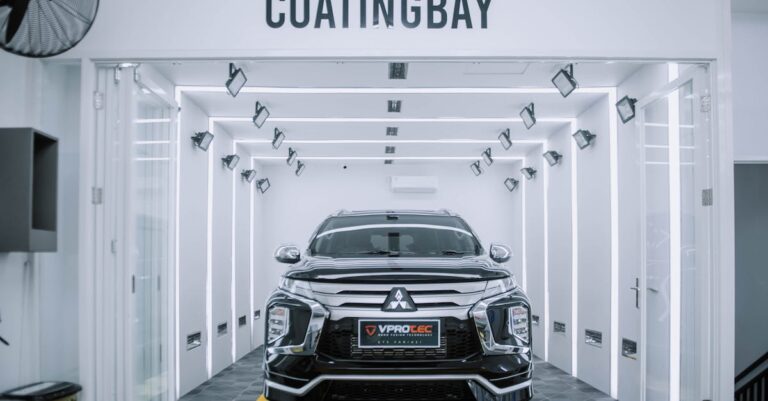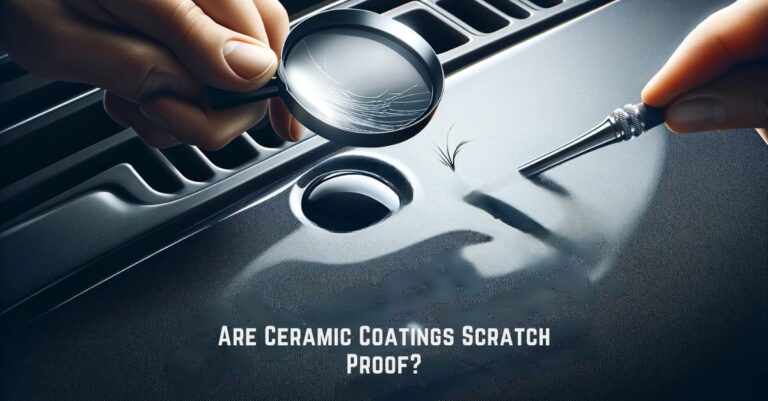Wax Over Ceramic Coating: Boost Shine & Protection
Protecting our car’s paint job is at the top of our maintenance list, and we’ve all heard about the wonders of ceramic coating. But what about adding wax on top? It’s a question that’s sparked debate among car enthusiasts and professionals alike.
In this article, we’ll dive into the nitty-gritty of whether waxing over ceramic coating is a brilliant move or a waste of effort. We’ll explore the benefits and potential drawbacks, ensuring you’re well-informed before making a decision.
Stick with us as we unravel the complexities of layering products on your vehicle’s exterior. By the end, you’ll know exactly how to keep your ride looking glossy and guarded against the elements.
Benefits of Ceramic Coating
When we delve into the benefits of ceramic coating, it’s essential to recognize the substantial protection it offers. Imagine your car’s paint job with an additional shield, capable of resisting environmental contaminants like bird droppings, tree sap, and UV rays. Ceramic coatings are known for their durability, often outlasting traditional carnauba wax by years, not just weeks.
The hydrophobic properties of ceramic coatings entail an impressive effect. Water beads and rolls off the surface effortlessly, reducing the likelihood of water spots and etching. This characteristic simplifies maintenance since road grime and dirt have difficulty clinging to the surface, making our car washing routine less frequent and more efficient.
Not only does a ceramic coating protect and ease cleaning, but it also enhances the car’s appearance. It adds a deep gloss to the paint, accentuating the vehicle’s color and providing a sleek, polished look. This shine is not just superficial; since ceramic coatings bond on a molecular level with the paintwork, it ensures a luster that lasts for a long time.
Here are some of the top benefits we see with ceramic coatings:
- Enhanced Durability: Lasts significantly longer than traditional waxes.
- UV Protection: Minimizes oxidation and fading of the paint.
- Chemical Resistance: Protects against acidic contaminants and pollutants.
- Easy Cleaning: The slick surface hinders dirt and grime from sticking.
- Glossy Finish: Offers a consistent and high-quality shine.
It’s essential to bear in mind that the performance of a ceramic coating greatly depends on the quality of the product and proper application. Reputable brands and professional installation ensure that we reap all the benefits a premium ceramic coating can offer. While ceramic coatings stand powerful on their own, the debate on whether to add wax on top is fueled by enthusiasts’ quest for that extra layer of shine and protection.
What Is Waxing?
When we talk about maintaining our vehicles, waxing is a time-honored tradition that many car enthusiasts swear by. Car waxes are blends of carnauba, beeswax, and other natural waxes combined with oils and solvents to add a layer of protection to your car’s paint. The main role of wax is to provide a protective barrier against the elements like sun, rain, and dirt, while also giving your car a remarkable shine.
Traditionally, waxing has been recommended as a regular maintenance routine, usually every few months, depending on the product used and environmental conditions. It’s important to note that the choice of wax, like any other car care product, is critical. There is a myriad of waxes available, ranging from paste to liquid forms, each offering varying degrees of protection, longevity, and gloss.
Here’s what we typically gain from waxing:
- Protection from UV rays which can fade paint over time
- A barrier against contaminants such as bird droppings and tree sap
- An increase in glossy appearance reflecting the care invested in the vehicle
It’s evident to us that applying wax has its benefits. However, with the advancement of technology in car care, specifically the introduction of ceramic coatings, the need and effectiveness of wax as a protective layer becomes less clear. Ceramic coatings have challenged the traditional wax approach due to their superior chemical composition and long-lasting protection. It’s undeniable that ceramic coatings do offer a longer-term solution, but the role of wax in this new context is often questioned by many car care aficionados.
Understanding the synergy between wax and ceramic coatings is vital for making an informed decision. The layer of wax may enhance the already hydrophobic nature of the ceramic coatings while potentially providing that extra level of luster that many are seeking for their prized possessions.
Benefits of Waxing
When considering the addition of wax over a ceramic coating, we’re looking at amplifying the gloss and adding a sacrificial layer that can be easily reapplied. Despite the advancements in ceramic technology, waxing remains popular for its aesthetic benefits. A quality wax enhances the deep, rich colors of a car’s paint, making it pop with a wet-look shine that’s hard to achieve with ceramic coatings alone.
Waxing not only boosts the car’s appearance; it also offers a smooth touch that’s immediately noticeable. The slickness added by a layer of wax improves surface slipperiness, which can contribute to a reduction in surface contaminants sticking to the car. Here are some key benefits of waxing on top of a ceramic coating:
- Added Gloss and Depth: Wax on top of a ceramic coating can increase the depth of shine, giving a luxurious finish.
- Improved Slickness: Wax layers can make surfaces slicker, thus dirt and debris are less likely to stick.
- Enhanced Hydrophobic Properties: Though ceramic coatings are hydrophobic, adding wax may boost water beading and sheeting effects.
- Cost-Effective Maintenance: Regular waxing is a cost-effective way to maintain the vehicle’s topcoat, between the more substantial ceramic coating refreshes.
It’s crucial to understand that not all waxes are suitable for use on top of ceramic coatings. We must select a wax that’s compatible with ceramic materials to avoid reducing the efficacy of the underlying protective layer. Typically, natural carnauba waxes are preferred due to their non-abrasive nature and easy application.
By applying wax over a ceramic coating, we’re giving ourselves the capability to revitalize the car’s exterior without much hassle. A thin layer of wax, applied every few months, keeps the surface looking pristine and extends the life of the underlying ceramic coating. Regular maintenance with compatible products supports a synergy between the wax and the ceramic coating, ensuring our vehicle remains protected and glossy.
Can Wax Be Applied on Top of Ceramic Coating?
When it comes to maintaining a car’s exterior, we often get asked, “Can wax be applied on top of ceramic coating?” The answer is a resounding yes. In fact, adding a layer of wax over a ceramic coating is an excellent way to boost shine and protect the investment you’ve made in your car’s paint.
Firstly, it’s crucial to emphasize that not all waxes are compatible with ceramic coatings. To prevent any adverse reactions, we need to make sure that the wax we choose is specifically designed to work with ceramic materials. Some wax formulas contain solvents or abrasive substances that could degrade the ceramic coating. Therefore, looking for waxes labeled ‘safe for ceramic coatings’ ensures that we don’t compromise the integrity of the underlying layer.
Though ceramic coatings alone provide substantial protection, we should consider the extra benefits of applying wax:
- Enhanced Appearance: Wax can add an extra layer of depth and gloss to our car’s finish, giving it that wet look that’s highly sought after.
- Improved Slickness: The slick surface created by the wax layer helps reduce dirt and debris buildup, which can keep our cars cleaner for longer periods.
- Easy Application: Waxing is a simple process and serves as an additional protective layer that’s easy to reapply as necessary.
After ensuring that our chosen wax is suitable for use on ceramic coatings, the application process is quite straightforward. We simply apply the wax following the manufacturer’s instructions, taking care to evenly distribute the product across the coated surfaces. It’s best done in the shade to avoid premature drying, which can make buffing off the wax more challenging. Regular waxing sessions, when done properly, will not only enhance the look of our cars but also ensure long-lasting protection for the ceramic coating underneath.
Maintaining the balance between enhancing aesthetics and protecting the car’s surface requires knowledge and the right products. With the proper wax and careful application, we can ensure that our vehicles look stunning while staying shielded from the elements.
The Debate: Pros and Cons of Waxing Over Ceramic Coating
When considering whether to apply wax over a ceramic coating, several pros and cons come into play. Delving into this debate helps us make more informed decisions about our vehicle’s maintenance.
Pros:
- Enhanced Gloss: Applying a high-quality wax over the ceramic coating can result in an exceptional shine. This additional gloss not only makes our cars look more luxurious but also accentuates the color depth and clarity.
- Additional Protection: Waxes can serve as an extra protective barrier against the elements. While ceramic coatings are already strong, the wax layer can help shield against minor abrasions and contaminants.
- Improved Hydrophobicity: Although ceramic coatings have excellent water-repelling properties, a top layer of wax can boost hydrophobic action, making water bead even more and slide off effortlessly.
Cons:
- Possible Compatibility Issues: We must be cautious about the type of wax we choose. Some waxes might not bond well with certain ceramic coatings, leading to a subpar finish or even reducing the effectiveness of the underlying coat.
- Maintenance Requirements: Wax on top of ceramic coatings will necessitate more frequent upkeep. Unlike ceramic coatings that last for years, wax layers require reapplication every few months.
- Risk of Hazing or Streaking: Incorrect application or choosing the wrong type of wax can cause hazing or streaking on the ceramic coating. We need to ensure proper application and compatibility to avoid dulling the vehicle’s appearance.
Key findings from the debate include understanding that the right type of wax can elevate the vehicle’s aesthetics and add protection, yet there’s a trade-off with maintenance frequency and the risk of potential compatibility issues. In our maintenance routine, it’s crucial to weigh these factors and choose a path that aligns with our preference for the car’s appearance and protection level.
How to Apply Wax on Top of Ceramic Coating
When you’re looking to apply wax on top of a ceramic coating, the first step is to ensure that the surface is immaculately clean. Any dirt or debris can hinder the wax’s ability to bond, which reduces its effectiveness and longevity. Start with a thorough wash using a pH-neutral shampoo, followed by drying the car completely with a microfiber towel to avoid water spots.
Before applying the wax, it’s essential to inspect the ceramic-coated surface. This isn’t just a cursory glance—we’re looking for any imperfections that need attention. If necessary, a light polish can be used to prepare the surface, but be sure to remove any polish residue completely before moving on.
When choosing a wax, opt for one that’s specifically designed to work with ceramic coatings. These waxes are formulated to enhance the existing properties of the coating rather than interfere with them. Apply the wax in thin, even layers using a foam applicator or a microfiber pad. This will ensure that the application is uniform and will prevent the buildup of excess product, which can lead to the hazing issues we’re trying to avoid.
Work in small sections and allow the wax to haze slightly, which typically takes about 5 to 10 minutes. Then, using a clean microfiber cloth, buff the surface to a brilliant shine. It’s important to note that over-application can reduce the hydrophobic properties of the ceramic coating, so more wax isn’t necessarily better.
Here are some quick tips to remember:
- Wash and dry the surface meticulously
- Inspect and prepare the surface before waxing
- Choose the correct wax compatible with ceramic coatings
- Apply wax in thin, even layers
- Buff to a high gloss after the wax has hazed
Remember to regularly maintain the waxed surface to ensure optimal performance and protection. Regular maintenance includes gentle washes to prevent contamination and potential degradation of both the wax and the ceramic coating underneath.
Maintaining the gloss and protection of your ceramic coating with a layer of wax might seem like an extra step, but the visually stunning and durable results speak for themselves. With careful application and routine upkeep, our cars can maintain that sought-after shine and defense against the elements.
Conclusion
We’ve walked you through the essentials of applying wax over a ceramic coating to enhance your car’s gloss and protection. Remember, the key to success lies in using the right products and techniques. By following our tips, you’ll ensure that your vehicle not only looks its best but also receives the extra shield against the elements. Regular maintenance will keep that showroom shine lasting longer. Trust us, your car will thank you for that extra layer of care.







